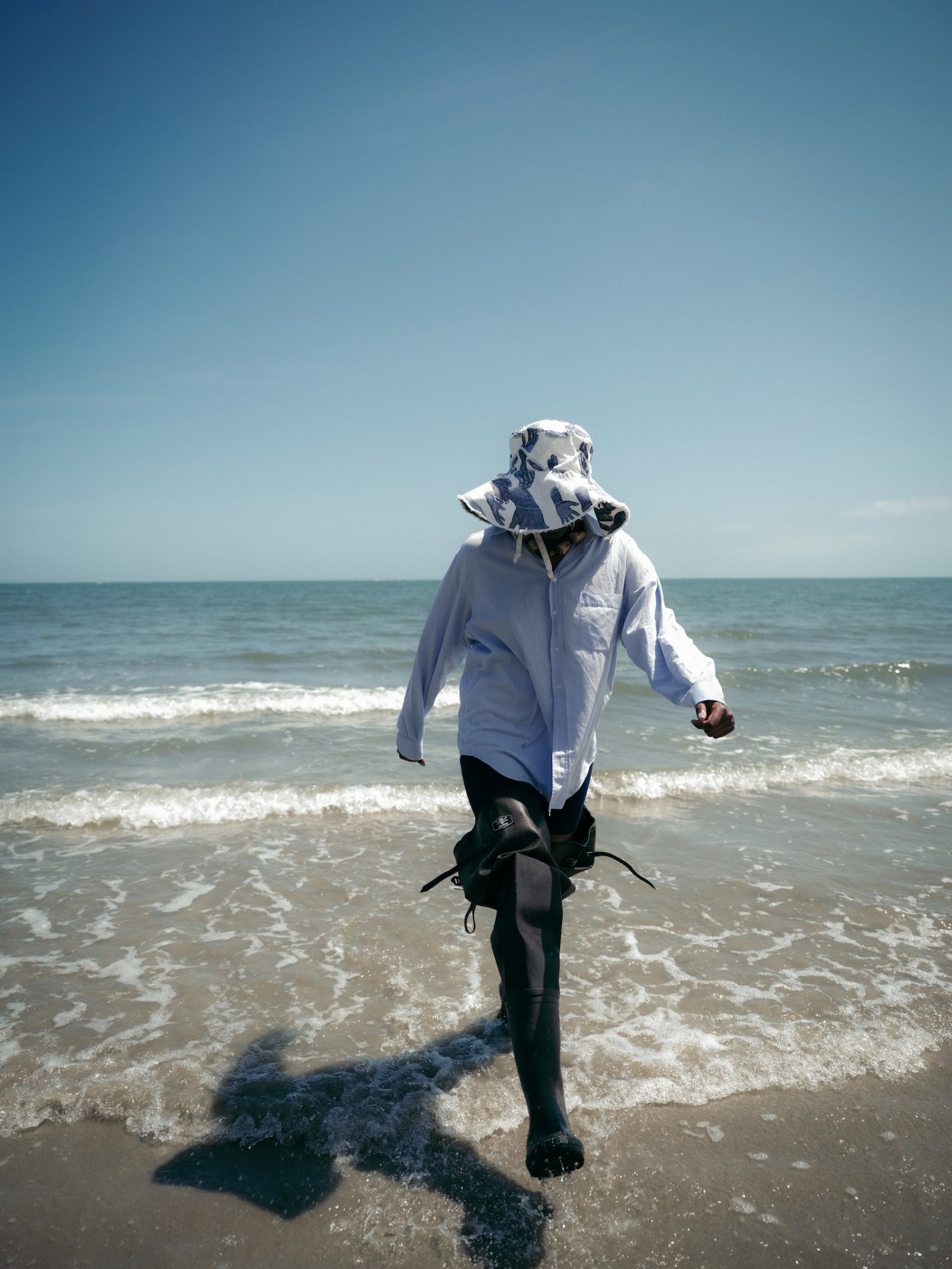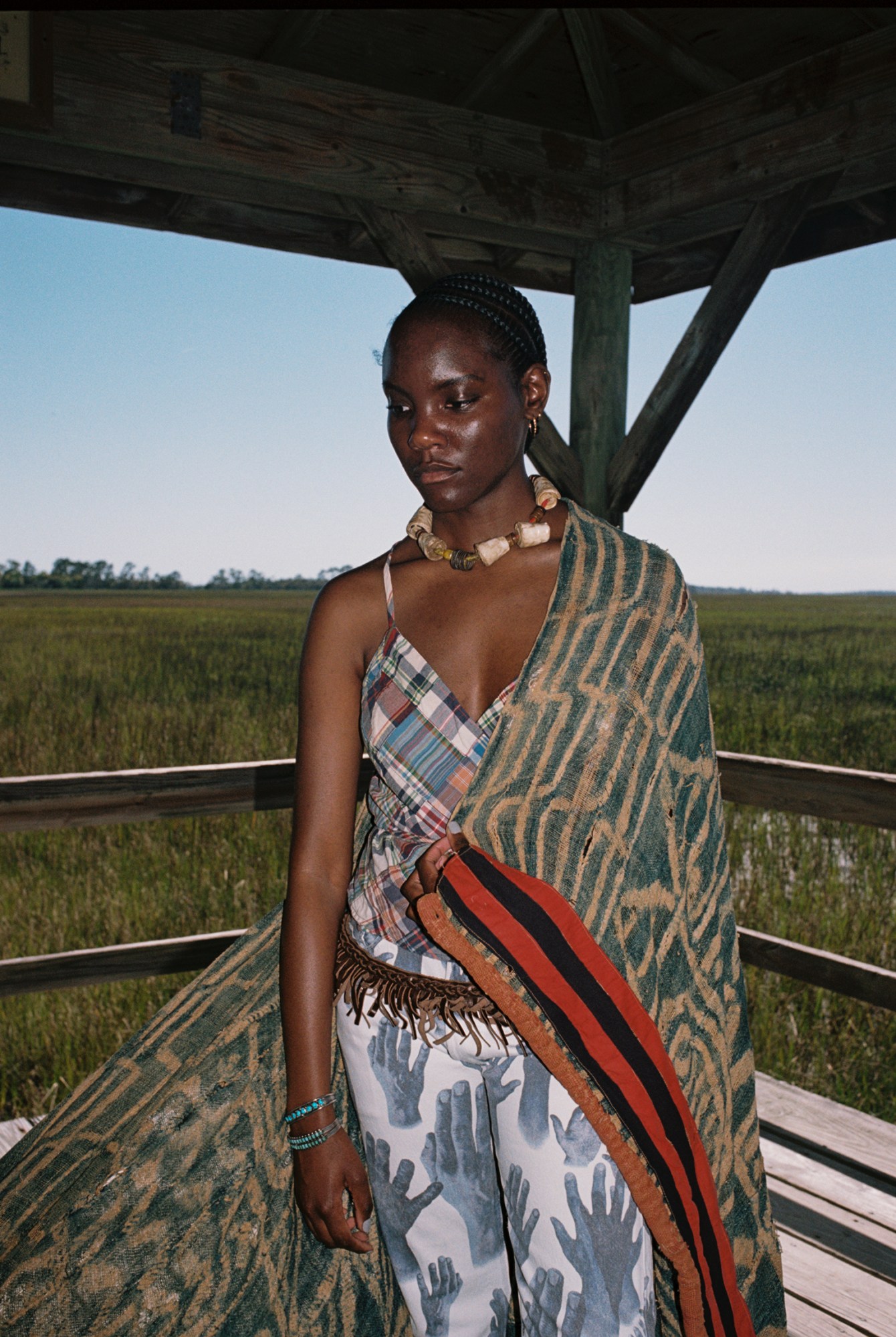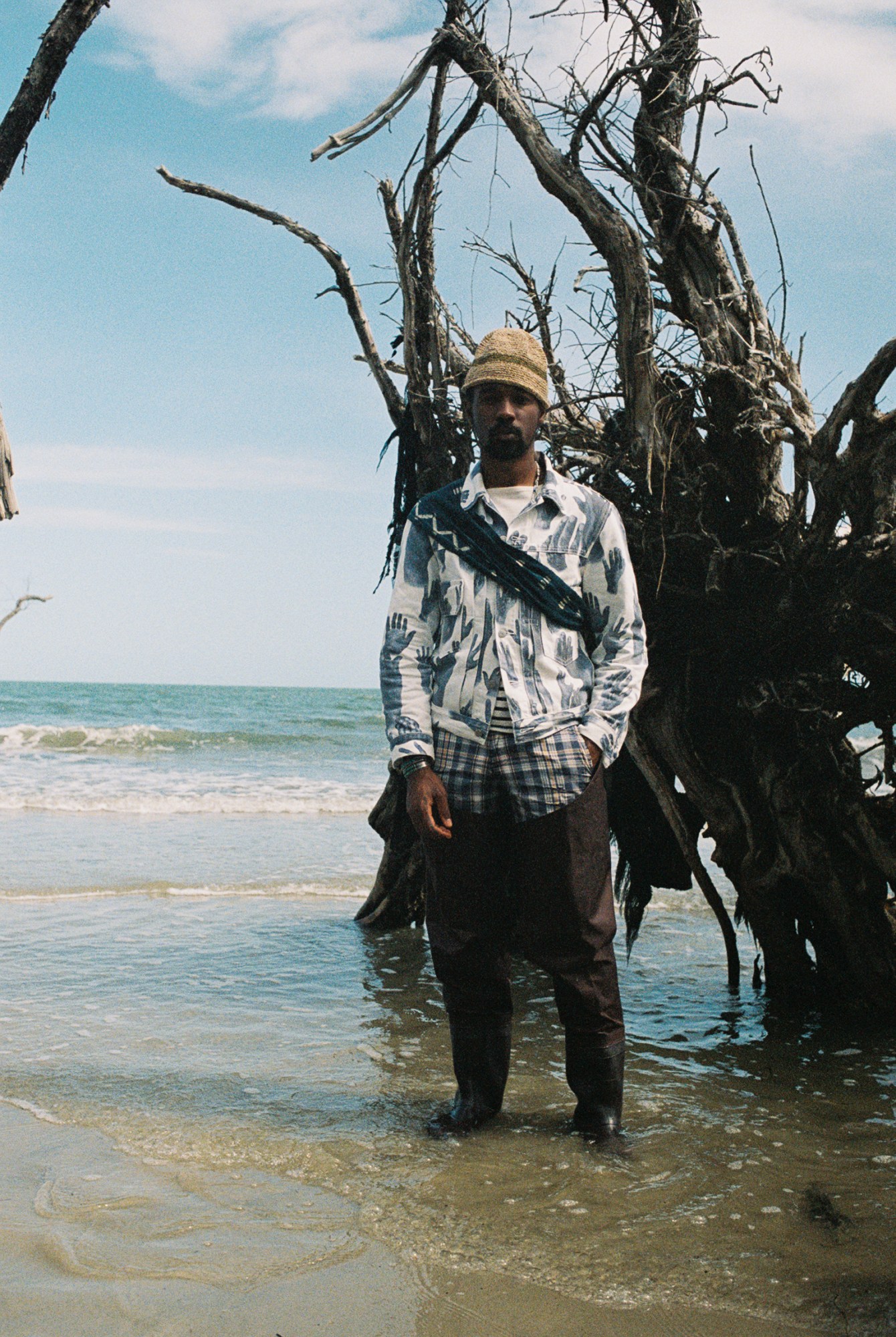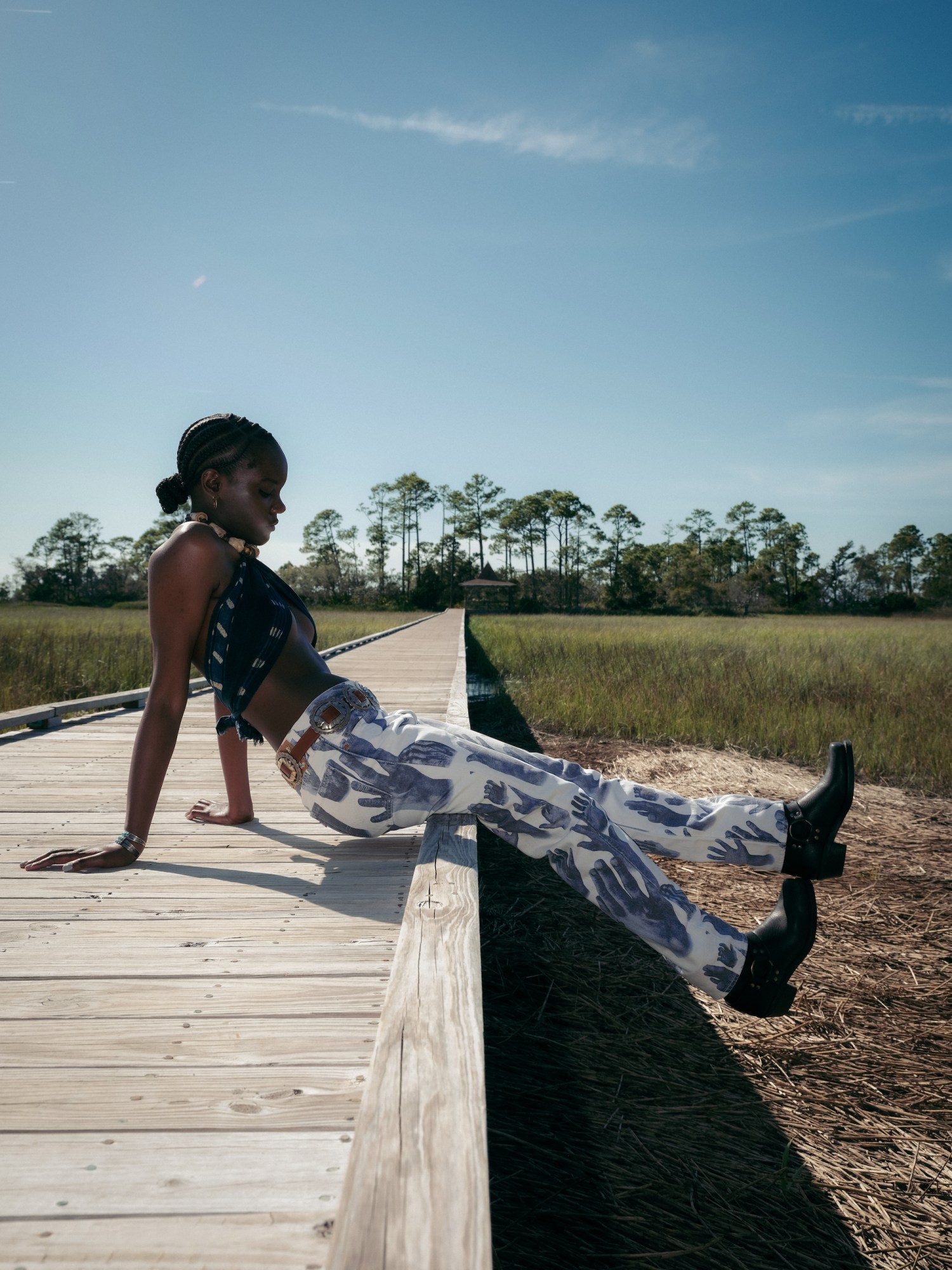Fashion is, very often, a creative discipline preoccupied with surfaces – with how things appear, rather than the complex stories and histories that underpin them. An exception to this rule, however, is Denim Tears, the label founded and headed up by Supreme creative director Tremaine Emory. Committed to interrogating America’s tumultuous past with respect to race, his work demonstrates how fashion can be used as a means to revisit overlooked histories – as well as the role that fashion has played within them.
One of the most notable projects that Tremaine has initiated through Denim Tears is a wildly popular collaboration with Levi’s. The first iteration spawned the viral Cotton Wreath jean, a riff on the denim giant’s iconic 501 printed with silhouettes of cotton flowers – a poignant reminder of the cruel history of slavery that allowed for the development of denim in the first place. For the second chapter of the collaboration, Denim Tears x Levi’s Season 2, Tremaine takes his excavation of the intersection of fashion and African-American history a step further, drawing on the history of the Gullah Geechee of coastal North and South Carolina for inspiration.
As the descendants of Africans that were enslaved on the rice, cotton and indigo plantations along America’s lower Atlantic coast, these three crops continue to hold deep relevance in contemporary Gullah Geechee culture. In the collection, the significance of the latter two is brought into relief through bleached denim Levi’s 501s, trucker jackets and plantation hats printed with indigo handprints. Elsewhere, shirt jackets, jeans and tote bags in bright quilts – another mainstay of Gullah Geechee cultural heritage – tell the story of the Gullah Geechee’s enforced voyage across the Middle Passage, while also highlighting their legacy of impeccable handcraft.
Granted, the stories that lie behind each piece aren’t necessarily obvious at first glance – and the majority of those that stop by the one-day-only Denim Tears x Levi’s pop-up events at the brand’s new shop-in-shop spaces at Dover Street Market locations worldwide won’t necessarily be au fait with Gullah Geechee history. But they needn’t be. After all, the value of these clothes lies in the fact that they prompt questions, opening the door to stories that, for too, long have gone untold both in fashion and culture at large.
Here, Tremaine discusses the rich network of references behind the new capsule, how his work serves as a conduit to new forms of knowledge, and how he hopes people will react to his politically potent work.

What was the jumping-off point for this second iteration of Denim Tears x Levi’s collaboration?
It was really when my friend Arthur Jafa told me about a film he was the cinematographer on – Daughters of the Dust, directed by Julie Dash. It was actually the first major Hollywood film directed by a Black woman. It’s about a Gullah Geechee matriarch and her kids and grandkids living on the islands off the coast of the Carolinas post-slavery. They kind of end up frozen in time, but the kids want to matriculate into regular society — they want to go to college, things like that – which the matriarch warns against. One of the notable things about her is that her hands are permanently dyed with indigo, as, when she was a slave, she made indigo at the behest of the United Kingdom – the biggest buyers of indigo due to the colour’s symbolic associations with royalty. After watching the film, I started doing further research into the history of indigo production during slavery, but there was only one book on it. It stated that slaves were specifically brought from parts of Africa where indigo dyeing was a part of the culture.
So that’s what led to the indigo-dyed handprints we see across the capsule?
Yes, but there’s actually a double meaning to them — it represents how the residue of slavery is embedded in these people’s skin, while also harkening back to the fact that slavery is embedded in America and wider Western culture. It’s not something you can wash away.

The film aside, what else was it that prompted your interest in the Gullah Geechee people?
Well, I’m really obsessed with Black indigenous cultures that have their own world and own systems of validation that are independent of Western culture. For many Black city folks, indexes of success might be things like going to an Ivy League school, having a Mercedes, or having a big house in a nice safe neighbourhood. To the Gullah Geechee people, however, they have their own cultural ecosystems and indexes of validation. There’s a real sense of dignity there which comes from having a rooted understanding of where you’re from and a sense of self-understanding.
The capsule’s other main motif is a colourful, printed quilting fabric. How did that come about?
Well, as I learned more about the Gullah Geechee people, I discovered that one of the ways they’ve traditionally used to communicate their stories and histories was quilting. To bring that story to life, we created a short film in which we went down and interviewed this amazing woman named Queen Quet, the Chieftess of the Gullah Geechee Nation, and basically just let her tell her story. Even though I’m Black, I’m still a voyeur, whereas she’s a part of that community — she makes quilts, she knows the story of indigo dyeing — so we decided to let her tell this story. With what I do, I never want to assume the role of teacher; rather, I want to act as more of a bridge or a conduit.

And what’s the story behind the symbols on the quilt?
There’s the African continent, a woman making indigo, the plantation slave masters house…. there’s even a slave ship and then there’s the church. I’ve always included religion in my work, which is something that people often don’t notice. It’s the thing that always placated slaves – It allowed them to believe that they could endure servitude in this lifetime as they’d eventually end up in heaven.
The sociopolitical context into which this second iteration of Denim Tears x Levi’s is arguably even more precarious and heated than it was when you released the first one. How do you hope it will resonate?
I think on a selfish level, I just like to make clothing and I enjoy doing that most when the work has some soul to it. For me, the primary intention is to express a story that matters to me. I can’t really control how people are going to receive that, though. For example, a very popular musician hit me up the other day, and said ‘Hey, I was wearing your jeans the other day, and my cousin asked me what kind of flowers were on them’. He didn’t realise that they were cotton flowers — and that’s not a bad thing, because it starts conversation. You don’t need to know the whole story behind something to be able to engage with it — but if someone finds it beautiful and wears it, the message is still getting out there whether they know it or not. When you make something, though, it’s kind of like opening up a pillow on a roof — you can’t really control where the feathers will go. I know my intentions when I create, and that’s ultimately what I’m most focussed on.




Denim Tears x Levi’s Season 2 pop-up shops will be taking place on the following dates: July 9th at Dover Street Market London; July 16th at Dover Street Market LA; July 23rd & 24th at Shopify New York. The collection will be available to purchase worldwide from July 26th on denimtears.com and the DSM e-shop.
Follow i-D on Instagram and TikTok for more on fashion.
Credits
Images courtesy of Denim Tears
